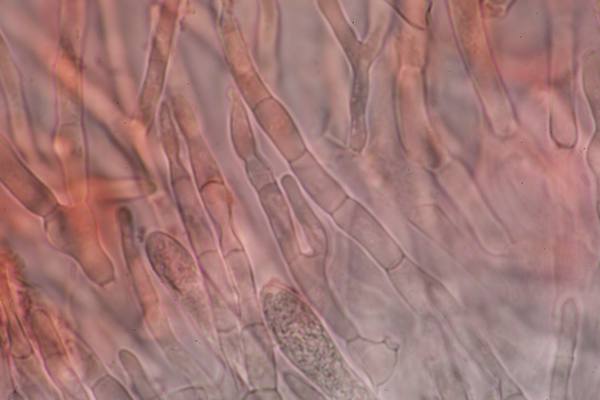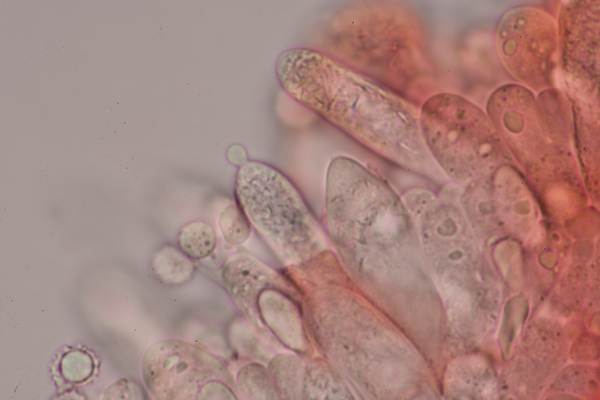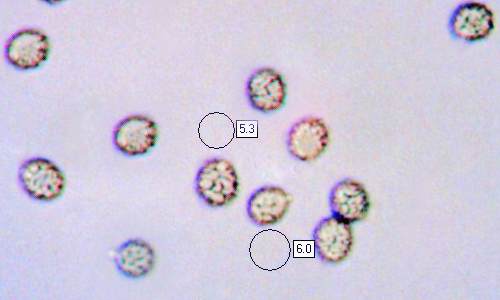Russula parazurea Jul. Schäff. - Powdery Brittlegill
Phylum: Basidiomycota - Class: Agaricomycetes - Order: Russulales - Family: Russulaceae
Distribution - Taxonomic History - Etymology - Identification - Culinary Notes - Reference Sources
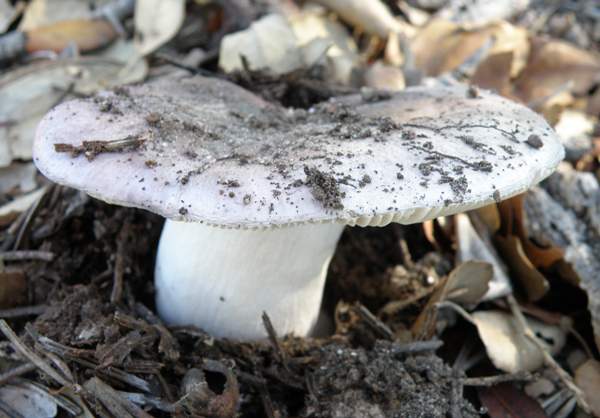
A powdery bloom and overall greyish appearance distinguish the caps of young Powdery Brittlegills. Some have a blue-grey tinge, while others show hints of purple, but something about this brittlegill usually betrays its identity even at a distance.
The specific epithet parazurea suggests that this species is similar to Russula azurea, and indeed the two are sometimes confused. (The white-spored Russula azurea occurs mainly under Norway Spruce and is rarely recorded in Britain.)
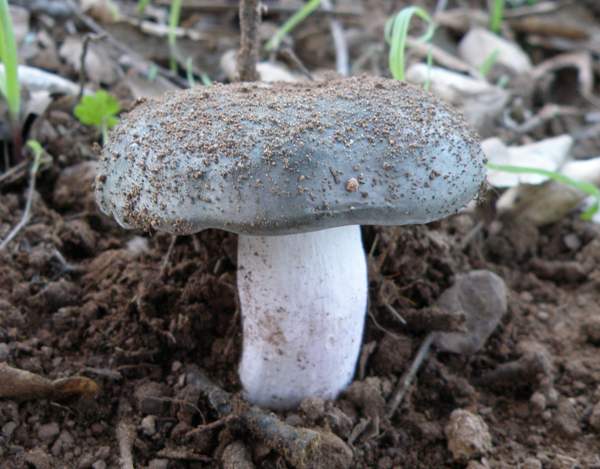
Distribution
Very common and widespread in and particularly beside paths and on edges of pine and mixed woodlands, the Powdery Brittlegill Russula parazurea occurs throughout Britain and Ireland as well as on mainland Europe, where it is partcularly common in the Mediterranean region.
There are disputed accounts of this species being found in North America, but if it does occur ther it is localised and very far from common.
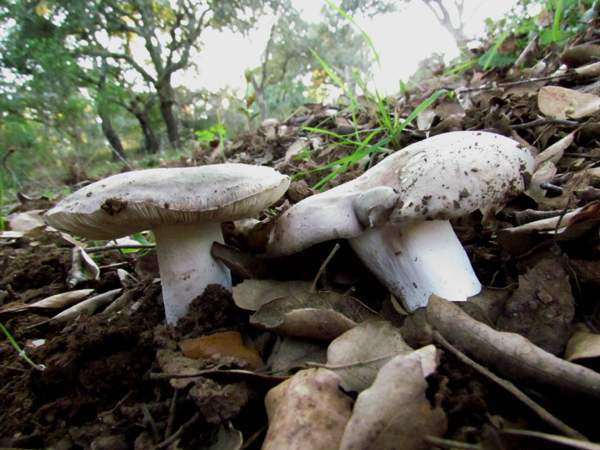
Taxonomic history
Russula parazurea was given its current name in 1931 by German mycologist Julius Schäffer (1882 - 1944).
Synonyms of this species include Russula palumbina ssp. parazurea (Jul. Schäff.) Konrad & Maubl.
Etymology
Russula, the generic name, means red or reddish, and indeed many of the brittlegills have red caps (but many more are not, and several of those that are usually red can also occur in a range of other colours!). The specific epithet parazurea means 'nearly blue'. (In France the common name given to this brittlegill is Russule Presque Bleu).
Identification guide
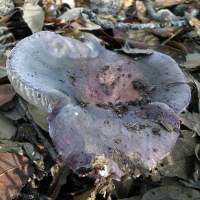 |
CapGrey and matt with a (often uniform) blue, blue-green or occasionally purple tinge and, when young and fresh, with a powdery bloom that eventually washes off; older caps of Russula parazurea flatten out and may become slightly depressed, and the margins often become striate and sometimes slightly toothed. Caps are rarely perfectly round and are often irregularly oval, 4 to 9cm across the major diameter. The cap flesh is white, and caps peel between 50 and 70% towards the centre. |
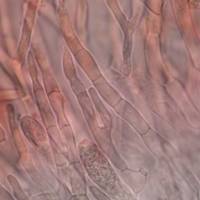 |
PileipellisThe pileipellis of Russula parazurea comprises hyphal cells 4 to 7µm in diameter and typically 30µm long; terminal cells are longer and taper towards the tips. |
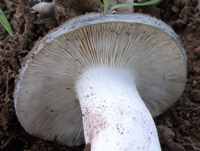 |
GillsPale cream, turning light ochre; adnexed; crowded. StemWhite, often with rusty spots mainly towards the base; cylindrical or slightly tapering towards the base; 6 to 6cm long and 0.7 to 1.5cm diameter. The stem flesh is pale brownish pink. |
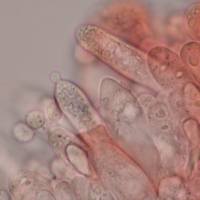 |
CheilocystidiaThese are the cystidia that occur on the gill edges. |
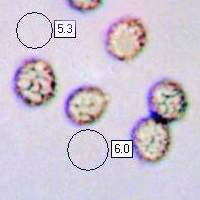 |
SporesEllipsoidal, 6-8.5 x 5-6.5µm, covered with warts up to 0.5µm tall most of which are joined by fine lines to form a moderately complete network. Spore printCream. |
Odour/taste |
Odour not distinctive; taste mild. |
Habitat & Ecological role |
Usually solitary or in very small groups in mixed woodland and under parkland oaks; mycorrhizal most commonly with oaks but also recorded occasionally under birches and spruces. |
Season |
July to October in Britain and Ireland; through to the New Year in Mediterranean countries. |
Similar species |
The Charcoal Burner, Russula cyanoxantha is sometimes greenish grey but is not covered in a fine bloom; it produces a white spore print and is notable for its extremely pliant (compared with other Russula fungi) gills. |
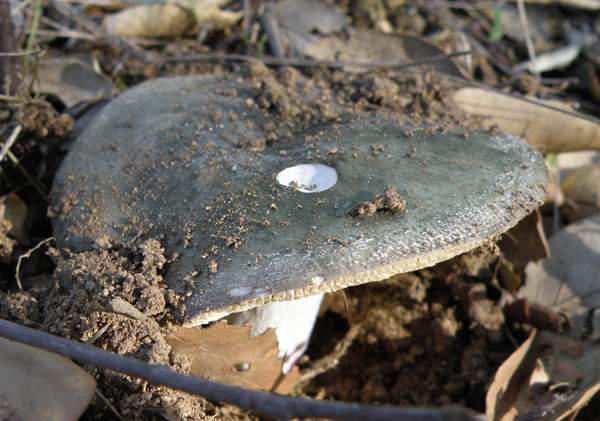
Culinary Notes
For those with the experience to identify them with certainty Powdered Brittlegills are edible mushrooms although reported to be of only mediocre quality. They are certainly suitable for bulking up mushroom dishes containing other tastier species, as they do retain a nice texture after being cooked; they can also be added to soups or stews.
Reference Sources
Pat O'Reilly (2016). Fascinated by Fungi, First Nature Publishing
Geoffrey Kibby (2011).The Genus Russula in Great Britain, published by G Kibby.
Roberto Galli (1996). Le Russule. Edinatura, Milan.
BMS List of English Names for Fungi
Paul M. Kirk, Paul F. Cannon, David W. Minter and J. A. Stalpers. (2008). Dictionary of the Fungi; CABI.
Taxonomic history and synonym information on these pages is drawn from many sources but in particular from the British Mycological Society's GB Checklist of Fungi.
Acknowledgements
This page includes pictures kindly contributed by David Kelly.
Fascinated by Fungi. Back by popular demand, Pat O'Reilly's best-selling 450-page hardback book is available now. The latest second edition was republished with a sparkling new cover design in September 2022 by Coch-y-Bonddu Books. Full details and copies are available from the publisher's online bookshop...
